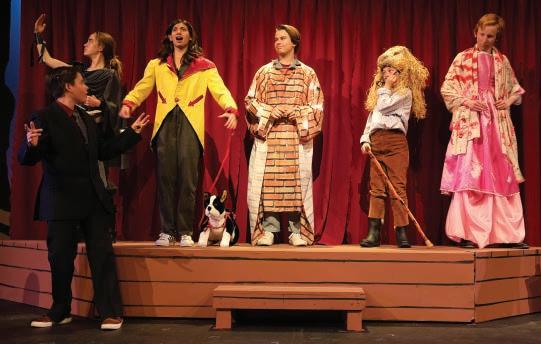
4 minute read
Cambodia
Journey on a Blue Boat
by Kathleen Gonzalez
While our blue wooden boat chugged down the Tonle Sap lake through Cambodia’s heartland, we talked about what had brought us to this land. Ashton Axe ‘22 said, “I’ve traveled to places that are like the U.S., so I wanted to see what the rest of the world is like.” But for Hayden Karnes ‘21, she “wanted to learn more about the genocide and the culture.” Eighteen Priory students, along with chaperones Amy Payne, Wes Bennicas ‘05, and myself, journeyed for over 26 hours to reach this country that we knew little about beyond Angkor Wat or the genocide of the 1970s. We were schooled in Cambodia’s history on our fi rst day when we visited Tuol Sleng, the infamous torture prison now turned museum. Our group even got to hear remembrances from Chum Mey and Buo Meng, the two living survivors. Andrew Dodson ‘21 refl ected that, “It stood out how the survivors were able to forgive even after everything that happened to them. It should be shared throughout the world, to see what’s wrong and improve for the future.” At the Killing Fields Genocide Center outside Phnom Penh, we saw the sites of former mass graves and the stupa to honor the dead. After visiting the Center, Angela Wang ‘20 commented, “I feel really bad for what happened in this country. I’m happy to see that they overcame so much in a short time.” Now our Rustic Pathways guides were taking us in this blue boat to Prek Tuol, a fl oating village of about 2,400 families. Our guide, Ra, came from such a village, while Sothy had worked with the local principal to build muchneeded houses. On that boat, we didn’t yet know that we’d be hammering fl oorboards, nailing bamboo slats, and tying wires to secure banana-leaf thatching to make walls. But after two days of intense work in 95-degree weather, we accomplished our goal: two new houses that we got to present to very happy families. “On this trip the results were so tangible. We actually sat with the families in their new house,” said Olivia Carusi ‘19. Liam Chandra ‘19 added, “I was changed by the service. Actually seeing the people and how they live made me realize that all the wires I tied and the nails I hammered really made a difference.” Each night we slept in host family houses under neon-bright mosquito netting. At the end of the workday, a bucket shower was surprisingly satisfying. On our fi nal night, Rustic Pathways guides Braden and Marina led a discussion about our service work. Aaliya Vasudevan ‘22 realized, “By doing this work, we’re not just helping these families, but we’re also taking some worry out of their lives so they can focus on something else.” Leaving the village, Romila Gargeshwari ‘22 realized that “It’s really important we did it because we might be inspired to do it again and in our own communities. I’m really privileged that this labor is


something fun for me because for many people that’s their life and they just have to work.” Considering our days of intense labor and sweat, a few hammered thumbs and upset tummies, Priory students were energized by their work. “The education aspect of it, that the family will be able to send their children to school now, I feel very proud to be part of that,” said Ada Fathers ‘20. Back in Siem Reap after our village life experience, we enjoyed an abundance of fun: Cambodian-style massage, shopping in the night market, the local circus, a tuk tuk ride, and the astonishing ancient temples of Angkor Wat, Bayon, and Pra Thom. Zach Brousseau ‘20 felt that “the itinerary was really balanced between seeing the city, doing service work, and learning about the local history.” We had experienced a hefty slice of Cambodia history and culture and found the people to be so kind. As Tatsuo Kumamoto ‘19 said, “Even if the government is strict, people fi nd a way to work around that and fi nd a way to be happy, from old people to children. Their energy is very rooted.” Nicole Shihadeh ‘20 added, “Being involved in a community that lacks the sort of privileges I have, seeing how they’re so kind to others, helps me see the contrast in how my community distances themselves from others. The Cambodians live such simple lives but fi nd such joy in it. We live such ornate lives but don’t always fi nd peace in it.” Journeying home, on a silver plane rather than a blue boat, we took with us new insights along with some of that Cambodian happiness.








